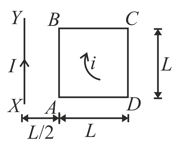A horizontal rod of mass 2 kg is kept touching two vertical parallel rough rails, carrying current. There is a magnetic field B = 2T present vertically downward. The rails are connected to battery of 100 V at t = 0. The resistance of the circuit is and starts to increase at constant rate The coefficient of friction between the rails and rod is (g = 10 m/s2 and separation between the rails in 1 m). Then,
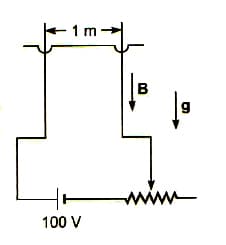
Important Questions on Moving Charges and Magnetism
The magnitude and direction of a force vector acting on a unit length of thin wire carrying a current at point , if the wire has a semicircular shape of radius as shown in the figure.
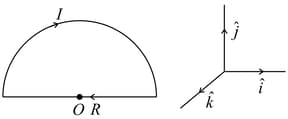
A wire carrying current is tied between points and and is in the shape of a circular arc of radius due to a uniform magnetic field (perpendicular to the plane of the paper, as shown in the figure) in the vicinity of the wire. If the wire subtends an angle at the center of the circle (of which it forms an arch) then the tension in the wire is:
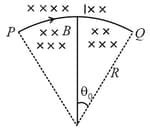
In a thin rectangular metallic strip a constant current I flows along the positive x - direction, as shown in the figure. The length, width and thickness of the strip are l, w and d, respectively. A uniform magnetic field is applied on the strip along positive y - direction. Due to this the charge carries experience a net deflection along the z-direction. This results in accumulation of charge carriers on the surface PQRS and appearance of equal opposite charges on the face opposite to PQRS. A potential difference along the z - direction is thus developed. Charge accumulation continues until the magnetic force is balanced by the electric force. The current is assumed to be uniformly distributed on the cross section of the strip and carried by electrons.

Consider two different metallic strips (1 and 2) of the same material. Their lengths are the same, widths are and and thicknesses are and , respectively. Two points and are symmetrically located on the opposite faces parallel to the - plane (see figure). and are the potential differences between and in strips 1 and 2 respectively. Then, for a given current flowing through them in a given magnetic field strength , the correct statement(s) is (are)
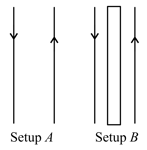
Let and be the magnitude of the force between the two wires in setup and setup , respectively.
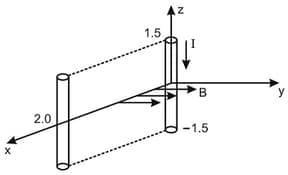


An elliptical loop having resistance , of semi major axis , and semi minor axis is placed in a magnetic field as shown in the figure. If the loop is rotated about the -axis with angular frequency , the average power loss in the loop due to Joule heating is :
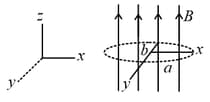
A copper rod of mass slides under gravity on two smooth parallel rails distance apart and set an angle to the horizontal. At the bottom, the rails are joined by a resistance in figure. There is a uniform magnetic field perpendicular to the plane of the rails. The terminal velocity of rod is
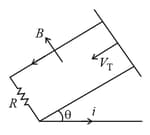
In a thin rectangular metallic strip a constant current I flows along the positive x - direction, as shown in the figure. The length, width and thickness of the strip are l, w and d, respectively. A uniform magnetic field is applied on the strip along positive y - direction. Due to this the charge carries experience a net deflection along the z-direction. This results in accumulation of charge carriers on the surface PQRS and appearance of equal opposite charges on the face opposite to PQRS. A potential difference along the z - direction is thus developed. Charge accumulation continues until the magnetic force is balanced by the electric force. The current is assumed to be uniformly distributed on the cross section of the strip and carried by electrons.

Consider two different metallic strips (1 and 2) of same dimensions (length , width and thickness ) with carrier densities and , respectively. Strip 1 is placed in magnetic field and strip 2 is placed in magnetic field , both along positive -directions. Then and are the potential differences developed between and in strips 1 and 2 respectively. Assuming that the current is the same for both strips, the correct option(s) is (are)
